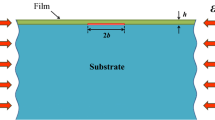Abstract
One of the most common forms of cohesive failure observed in brittle thin film subjected to a tensile residual stress is channel cracking, a fracture mode in which through-film cracks propagate in the film. The crack growth rate depends on intrinsic film properties, residual stress, the presence of reactive species in the environments, and the precise film stack. In this paper, we investigate the effect of various buffer layers sandwiched between a brittle carbon-doped-silicate (CDS) film and a silicon substrate on channel cracking of the CDS film. The results show that channel cracking is enhanced if the buffer layer is more compliant than the silicon substrate. Crack velocity increases with increasing buffer layer thickness and decreasing buffer layer stiffness. This is caused by a reduction of the constraint imposed by the substrate on the film and a commensurate increase in energy release rate. The degree of constraint is characterized experimentally as a function of buffer layer thickness and stiffness, and compared to the results of a simple shear lag model that was proposed previously. The results show that the shear lag model does not accurately predict the effect of the buffer layer.
Similar content being viewed by others
References
Q. Ma: A four-point bending technique for studying subcritical crack growth in thin films and at interfaces. J. Mater. Res. 12, 840 (1997).
M. Lane, N. Krishna, I. Hashim and R.H. Dauskardt: Adhesion and reliability of copper interconnects with Ta and TaN barrier layers. J. Mater. Res. 15, 203 (2000).
T.Y. Tsui, A.J. Griffin Jr., J. Jacques, R. Fields, A.J. McKerrow, and R. Kraft: Effects of elastic modulus on the fracture behavior of low-dielectric constant films, in Proceedings of the 2005 IEEE International Interconnect Technology Conference (IEEE Electronic Devices Society, Piscataway, NJ, 2005), pp. 63–65.
A.A. Volinsky, P. Waters, J.D. Kiely and E. Johns: Sub-critical telephone cord delamination propagation, in Stability of Thin Films and Nanostructures, edited by R.P. Vinci, R. Schwaiger, A. Karim, and V. Shenoy ( Mater. Res. Soc. Symp. Proc. 854E, Warrendale, PA, 2004), U9.5.
J.J. Vlassak: Channel cracking in thin films on substrates of finite thickness. Int. J. Fracture 119(4), 299 (2003).
R.F. Cook and E.G. Liniger: Stress-corrosion cracking of low-dielectric-constant spin-on-glass thin films. J. Electrochem. Soc. 146, 4439 (1999).
J.L. Beuth Jr.: Cracking of thin bonded films in residual tension. Int. J. Solids Struct. 29, 1657 (1992).
J. Dundurs: Edge-bonded dissimilar orthogonal elastic wedges. J. Appl. Mech. 36, 650 (1969).
B.R. Lawn: Fracture of Brittle Solids, 2nd ed. (Cambridge Press, Cambridge, U.K., 1993).
S.M. Wiederhorn and H. Johnson: Effect of electrolyte pH on crack propagation in glass. J. Am. Ceram. Soc. 56(4), 192 (1973).
T.H. Courtney: Mechanical Behavior of Materials (McGraw-Hill Publishing Company, New York, 1990).
Z. Suo: Reliability of interconnect structures, in Interfacial and Nanoscale Fracture, Comprehensive Structural Integrity, Vol. 8, edited by I. Milne, R.O. Ritchie, and B. Karihaloo (Elsevier, Oxford, U.K., 2003), pp. 265–324.
J. He, G. Xu and Z. Suo: Experimental determination of crack driving forces in integrated structures, in Proceedings of the 7th International Workshop on Stress-Induced Phenomena in Metallization, edited by P.S.W. Ho, S.P. Baker, T. Nakamura, and C.A. Volkert (American Institute of Physics, New York, 2004), pp. 3–14.
Author information
Authors and Affiliations
Additional information
This paper was selected as the Outstanding Meeting Paper for the 2005 MRS Spring Meeting Symposium B Proceedings, Vol. 863.
Papers in this section are based on submissions to the MRS Symposium Proceedings that were selected by Symposium Organizers as the outstanding paper. Upon selection, authors are invited to submit their research results to Journal of Materials Research. These papers are subject to the same peer review and editorial standards as all other JMR papers. This is another way by which the Materials Research Society recognizes high quality papers presented at its meetings.
Rights and permissions
About this article
Cite this article
Tsui, T.Y., McKerrow, A.J. & Vlassak, J.J. Constraint Effects on Thin Film Channel Cracking Behavior. Journal of Materials Research 20, 2266–2273 (2005). https://doi.org/10.1557/jmr.2005.0317
Received:
Accepted:
Published:
Issue Date:
DOI: https://doi.org/10.1557/jmr.2005.0317




